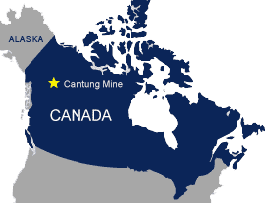 |  | |||||||||||||||||||||||||||||||||||||||||||||||||||||||||||||||||||||||||||||||||||||||||||||||||||||||||||||||||||||
 |

NORTHWEST TERRITORIES, CANADA NTS Area: 105 H/16 Latitude/Longitude: 61.9717°N, 128.2683°W Ore Type: oxide Mining Method: underground and open pit Access: 306 km, all weather road from Watson Lake, Yukon Project Status: Operating Cantung is one of the largest operating tungsten mines outside of China. Production occurs from the seasonally operated open pit and the continuously operating underground mine. The mine currently produces ore at a rate of 1,350 dry short tons per day. Mineral Reserves support a mine life to at least 2017. LOCATION The Cantung Mine is located in the Nahanni area of western Northwest Territories, Canada, approximately 300 km by road northeast of Watson Lake, Yukon, close to the Yukon border. HISTORY Prospectors discovered the Cantung Mine tungsten deposit in 1954, while looking for copper. In 1959, the Canada Tungsten Mining Corporation Ltd. was formed to acquire and develop the property. The Cantung Mine commenced production in 1962 from an open pit at the rate of 300 tons per day (stpd), with suspensions in 1963 due to low tungsten prices and in 1966 due to the destruction of the mill by fire. The construction of a new 350 stpd mill was completed in 1967 and in 1969 the capacity was increased to 450 stpd. In 1971, drilling discovered the "E Zone". This zone was accessed through an adit collared at the valley bottom, close to the town site. The mill began to process the underground ore in 1974. In 1975, the mill was further expanded to 500 stpd. A major mill expansion in 1979 increased the mill capacity to 1,000 stpd. In 1985, Amax Inc consolidated ownership of the Cantung Mine and transferred all tungsten assets, including the Mactung Project at Macmillan Pass, to Canada Tungsten Mining Corporation, retaining majority control. Aur Resources Inc. (Aur) purchased Amax Inc's controlling interest in 1995 and Canada Tungsten and Aur merged in 1996. In 1997, North American Tungsten Corporation Ltd. ("NATCL") purchased the Cantung mine, together with the related tungsten assets of the former Canada Tungsten Inc., from Aur. After an improvement in tungsten prices commencing in 2000, NATCL reopened the Cantung mine in December 2001. Underground production and milling resumed at this time. In December 2003, NATCL was placed under the protection of the Companies Creditors Arrangement Act (CCAA), and the mine was closed. In November 2004, NATCL successfully completed a plan of arrangement to deal with creditors, allowing planning for reopening to commence. Preparatory work for the reopening began in July 2005, and production resumed in late September 2005. The Cantung mine suspended operations in October 2009 and resumed production in October 2010 and the operation has remained in continuous operation to the present day. TECHNICAL REPORT ON THE CANTUNG MINE The following information is based on a technical report prepared by Brian Delaney, P. Eng. and Finley Bakker, P. Geo. in a report titled "Technical Repot on the Cantung Mine, Northwest Territories, Canada", dated September 19, 2014 file on November 3, 2014 at www.sedar.com. MINERAL RESOURCE AND MINERAL RESERVE ESTIMATES The Cantung mine, owned and operated by the North American Tungsten Corporation Ltd. (NATCL), is a tungsten mine in the Northwest Territories, Canada. Cantung is one of the largest operating tungsten mines outside of China. The mine consists of both open pit and underground operations, which extract ore from a scheelite-chalcopyrite bearing skarn. The skarn deposit formed as a replacement to the Ore Limestone and Swiss Cheese Limestone units located on the property. Production occurs from the seasonally operated open pit and the continuously operating underground mine. The mine currently produces ore at a rate of 1,350 dry short tons per day. Mineral Reserves support a mine life to at least 2017. The primary mining method is sub-level longhole stoping with delayed backfill. Currently longhole methods are planned for the majority of the remaining reserves with cut and fill being employed in areas where the ore zone is too narrow for efficient longhole mining. Processing is carried out by gravity and flotation circuits. Final products include a premium gravity concentrate (G1), containing on average, 65% WO3; a flotation concentrate containing, on average, 35% WO3 and a copper concentrate averaging 28% Cu. Exploration on the property continues with both in-mine and near-mine exploration programs underway. This has been successful in defining additional ore sources and adding mineral resources and reserves. When production is taken into account, Mineral Reserve tonnages have increased since the previous NI 43-101 technical report in 2011. These increases are due to successful exploration and mineral reserve definition in new ore zones, combined with the inclusion of lower-grade areas rendered economic by higher tungsten prices. Mineral Reserves now support a mine life to at least 2017. These mineral resources and mineral reserves, calculated as of July 31, 2014, are listed below in Table 1.1, Table 1.2 and Table 1.3.
Table 1.1 - Probable Mineral Reserves, July 31, 2014
Notes:
Table 1.2 - Indicated Mineral Resources, July 31, 2014
Notes:
Table 1.3 - Inferred Mineral Resources, July 31, 2014
Notes:
Mineral Resources where insufficient work has been completed to date to demonstrate economic viability have been excluded in determining the Mineral Reserves. Additional work may demonstrate economic viability for part of these Mineral Resources. Mineral Resources that are not Mineral Reserves do not have demonstrated economic viability. QUALIFIED PERSON Brian Delaney, P. Eng., the Company's Assistant Mine Manager and Finley J. Bakker, P. Geo., the Company's Superintendent of Technical Services are both qualified persons as defined by NI 43-101. DETAILS OF THE TECHNICAL REPORT ON THE CANTUNG MINE, NORTHWEST TERRITORIES, CANADA DATED SEPTEMBER 19, 2014 ARE AVAILABLE AS NATIONAL INSTRUMENT 43-101 TECHNICAL REPORT FILED ON SEDAR. TO VIEW THE REPORT CLICK HERE. |
|||||||||||||||||||||||||||||||||||||||||||||||||||||||||||||||||||||||||||||||||||||||||||||||||||||||||||||||||||||
| Disclaimer |